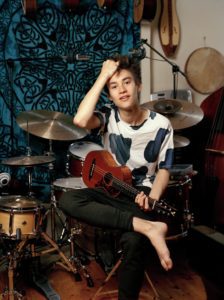Jazz Fest
By • June 7, 2017 0 571

B
ack in 2004, there was no such thing as a DC Jazz Festival, which, when you think of the rich jazz history of this city and its deep pool of talented musicians, is almost sinful to contemplate.
Charlie Fishman, then manager and agent of bebop trumpet legend Dizzy Gillespie, thought so, and set about creating what was christened the Duke Ellington Jazz Festival in 2004. Renamed in 2010, the DC Jazz Festival is now in the midst of setting up shop all over the city.
The name and the parts may have changed, but at heart the festival is becoming something it was always meant to be. Just look at the components of this year’s festival and you get a sense of its flavor, meshing international, national and local themes in a way few festivals do.
There’s DC Jazz Fest at the Howard Theatre (June 9, 10 and 13), something of a salute to the Howard’s own role in the city’s grander jazz days, while offering a mix of star power and electric new talent.
There’s A Night at the Kennedy Center (June 12), subtitled: An Evening with Pat Metheny, featuring Antonio Sanchez, Linda Oh and Gwilym Simcock.
There’s the innovative city- and neighborhood-centered Jazz in the ’Hoods (June 9 to 18), which reaches into all four quadrants and eight wards. These performances in parks, schools, restaurants and clubs make it a truly citywide festival.
From that springs the Capital Bop DC Jazz Loft Series (June 9, 10 and 16), a free-floating, cutting-edge string of performances in nontraditional, non-jazz venues.
Not to forget, the DC Jazz Fest at the Yards in the Capitol Riverfront neighborhood (June 16 to 18).
“I think what we have is unique and original,” said Sunny Sumter, the festival’s executive director. “It’s truly our festival, as well as having national and international stature. The festival, with its many different features, but especially with the Jazz in the ’Hoods component, reaches out into the whole city. It highlights that we are a jazz city. There’s also the fact that this city is so rich in gifted and talented musicians. This year, over half the musicians performing in the festival are local.”
Festival Artistic Director Willard Jenkins sees it as an evolutionary process, in alignment with the evolution in the form itself.
“Time was when American jazz musicians would go overseas and play, mostly in Europe, and it was considered something of an exotic art form and got very popular there,” said Jenkins, a jazz historian and journalist.
Jazz has become a truly international force. Every region of the world is nurturing jazz musicians, and that gets reflected in what jazz itself becomes and how it’s played …The musicians bring their own experience to the music.
-Willard Jenkins
“Also, early on, jazz was dominated by charismatic, star-power performers like Dizzy, Charlie Parker, Miles Davis, Billie Holiday, Thelonius Monk and others. That’s changed too.
“What’s happened is that jazz has become a truly international force. Every region of the world is nurturing jazz musicians, and that gets reflected in what jazz itself becomes and how it’s played. These players from Asia, Africa, Latin America, India and Europe, as well, influence the sound. The musicians bring their own experience to the music.
“That’s reflected in the diversity and variety in our own festival. Today, there are more talented jazz players around the world than there ever were. The festival is very much about the future, but it’s also true that this is a city with a great and long jazz history.”
There are always changes, of course: Bohemian Caverns on U Street, a classic club and a big supporter of the festival, is no longer here.
This year, the festival returns to some of its and the city’s roots when it opens at the historic Howard Theatre. Howard Theatre principal Chip Ellis said, “We’re thrilled to continue building on the Howard’s storied jazz legacy, which includes icons like Ella Fitzgerald, Duke Ellington and Louis Armstrong.”
Topping the bill at the opening night ceremony on June 9 is Grammy Award-winning vocalist Lalah Hathaway, daughter of legendary star Donny Hathaway. The Howard schedule also includes a “Jazz Legends Double Feature,” the Roy Haynes Fountain of Youth Band and Ron Carter-Russell Malone Duo on June 10, and the Hiromi & Edmar Castañeda Duo on June 13.
Probably the most innovative aspect of the DC Jazz Festival almost from the get-go has been Jazz in the ’Hoods, which runs throughout the festival and the city. The net here is cast wide with performances in 20 neighborhoods, including Georgetown, where there will be shows at Blues Alley and the Graham Hotel, and free and affordably priced programs east of the Anacostia River.
In the Capital Bop Jazz Loft Series, guitarist Mary Halvorson and Odean Pope’s Saxophone Choir are partnering with Dance Place on 8th Street NE for In Jazz We Trust: Music in Motion (June 10 and 11).
The DC Jazz Fest at the Yards will feature prodigy newcomer, singer, arranger and composer Jacob Collier, a multi-instrumentalist with a huge international audience that sprang from YouTube. Other artists at the Yards will include Nigerian-British singer Ola Onabule, the Grammy-winning Robert Glasper Experiment, saxophonist Kenny Garrett and rising vocalist Kandace Springs.
Also as part of the festival, the Kennedy Center’s Millenium Stage — always free and always at 6 p.m. — will present a series called Bass-ically Yours that highlights the area’s wealth of bass-playing bandleaders. The lineup is: Amy Shook (June 11), James King (June 12), Tommy Cecil (June 14), Herman Burney (June 15), Trio Vera (June 16) and Kristopher Funn (June 19).


